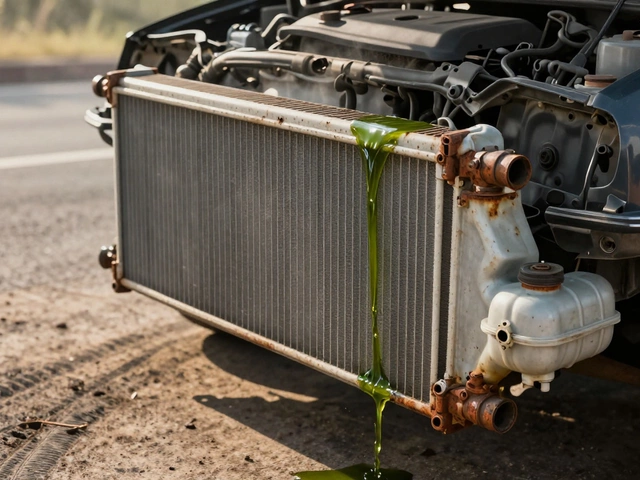It's easy to overlook the humble spark plug, despite it being central to your car's well-being. These tiny components ignite the fuel-air mixture in the engine cylinders, a critical process for your vehicle's performance. When they malfunction, you might notice some telltale signs that shouldn't be ignored.
Recognizing these symptoms early can save you from long-term engine damage and high repair costs. Understanding the warning signals set off by faulty spark plugs equips you to address these issues promptly, ensuring a smoother and safer drive.
- Recognizing Performance Problems
- Inspecting Physical Signs
- Impact on Fuel Efficiency
- Tips for Replacement and Maintenance
Recognizing Performance Problems
When it comes to staying in tune with your vehicle, knowing the typical engine issues related to faulty spark plugs is vital. A bad spark plug often makes its presence known through a series of unmistakable cues, with engine misfires being one of the most prevalent. These misfires are interruptions in the combustion process and can cause your car to shake or jerk unexpectedly. It is akin to an orchestra missing a key instrument; the performance falters. These disruptions can manifest both when starting your engine and while the vehicle is running, creating palpable hiccups at idle or during acceleration.
An unexpected increase in exhaust emissions can also point to falling spark plugs. When your engine doesn't burn fuel effectively, it produces higher carbon emissions that can exacerbate environmental pollution. This is not merely a performance issue but a concern for the responsible motorist who is conscientious about the environment. An intriguing fact from The Environmental Protection Agency highlights that a vehicle with worn components can emit up to 40% more pollutants than one maintained regularly. This statistic underscores why addressing spark plug issues is crucial for both performance and ecological stewardship.
Start-up difficulties often surface when spark plugs are failing. As these components age, their ability to ignite the air-fuel mixture weakens. You might notice the engine cranking more than usual before firing or might need to attempt multiple starts before you're successful. This can be particularly bothersome on cold mornings when internal combustion engines need more voltage to kick off. A malfunctioning spark plug can increase this struggle, adding extra wear and tear on your battery and starter.
Another sign closely tied to performance issues is the car hesitating during acceleration. Imagine pressing the pedal with the expectation of a smooth, responsive increase in speed, only to feel a noticeable lag. This hesitation is a direct consequence of incomplete combustion cycles resulting from unreliable spark plugs.
The automotive expert, John H. Davis, once noted, "The heartbeat of an engine lies in its spark—the plug. A simple check of this small component can save heartache down the road."This emphasizes the unseen power these components wield over vehicle dynamics.
If these signs resonate with your current driving experience, it might be time to check those spark plugs. As small as these components are, their role in maintaining vehicle performance is outsized. Replacing spark plugs is not merely a matter of upkeep; it is a preventive measure that ensures your car remains a dependable companion on the road, ready to perform at its best whenever duty calls.

Inspecting Physical Signs
Diving under the hood to check your spark plugs can feel daunting if you haven't done it before, but it's a skill worth having. The physical condition of a spark plug can tell a lot about your engine's health. Start by locating the plugs, often found at the end of thick wires stemming from the engine. Once you’ve safely removed one, examine it closely for any visible damage or wear.
A healthy spark plug typically has a light brown to grayish tan appearance on the electrode insulator and is free from deposits. If you notice heavy buildup, like a black sooty deposit, this signals that your engine is running too rich, burning excessive fuel. On the other hand, a lean fuel mixture, where there's too much air and not enough fuel, can cause the spark plug to appear white or blistered. Both scenarios reflect flawed combustion, harming your vehicle's performance.
Common Signs of Deterioration
Cracks in the porcelain insulator, melted electrodes, or excessive pitting and erosion can indicate a failure caused by an overheating engine or using the wrong type of spark plug. According to Car and Driver, if a spark plug appears wet or oily, it points to oil contamination, which often means there's another problem afoot, such as worn piston rings or valve guides:"Oily plugs might suggest oil is leaking into the combustion chamber, which suggests your car might have engine wear or broken gaskets," reports the renowned automotive magazine.
Conduct routine inspections in well-lit conditions to accurately assess the condition of each spark plug. If multiple plugs show damage, the issue could be systemic, perhaps linked to incorrect engine settings or maintenance oversight. Maintenance of your vehicle must involve periodic checks of essential parts like spark plugs, ensuring optimal function and forestalling costly repairs down the road.
Data Table: Ideal Spark Plug Appearance
For a quick reference on what normal and abnormal spark plugs should resemble, consider the following:| Condition | Appearance | Possible Cause |
|---|---|---|
| Normal | Light gray or tan | Healthy combustion |
| Sooty Black | Thick carbon deposits | Rich fuel mixture |
| White/Burned | Porcelain is blistered | Lean fuel mixture |
| Oily | Wet or greasy | Oil incursion |
Keeping an eye on these physical signs can ensure your car works efficiently, preventing frequent engine hiccups. As you get in tune with inspecting your spark plugs, you'll gain confidence in managing your car’s basic health and learn to catch minor issues before they become major setbacks.

Impact on Fuel Efficiency
When it comes to keeping your vehicle in top-notch condition, focusing on spark plugs and how they affect fuel efficiency is crucial. A faulty spark plug can act like a stealthy thief, siphoning off your vehicle performance and hard-earned money. The energy they use to generate the spark directly influences fuel combustion. If this ignition process falters, your car's engine might burn more fuel than necessary, resulting in a direct hit to your wallet at the pump.
Bad spark plugs can lead to incomplete combustion, which means unburned fuel leaves the engine through the exhaust. This can decrease fuel efficiency by a whopping 30%, costing the average driver hundreds of dollars annually. Additionally, lower fuel efficiency not only affects the financial aspect but can increase emissions, thus having an environmental impact. It’s interesting to note that one of the earliest signs might be a spike in the frequency of your trips to the gas station, a strange occurrence if you haven't been driving any differently.
Car maintenance often includes checking spark plugs for wear and tear, such as carbon buildup, or deposits which can inhibit the spark. In line with this, modern vehicles should ideally have their spark plugs inspected every 30,000 miles or as recommended by the manufacturer. Ignoring this could lead to knock-on effects such as damaging catalytic converters, further spiraling repair costs.
In an insightful piece by the
Car Maintenance Institute states, "Ignoring the spark plug inspection can lead to a 10% decrease in fuel efficiency without altering the driving pattern".This highlights the importance of routine checks. Investing time in routine maintenance and being aware of the symptoms can save larger problems down the road.
Intuitively, with the knowledge of how spark plugs affect fuel economy, drivers find themselves better equipped to deal with their vehicles and avoid unnecessary expenses. While it's tempting to put off small tasks like spark plug checks, addressing them promptly can make a profound impact, bringing long-term value to your car maintenance regime and ensuring your traveling is as efficient as possible.

Tips for Replacement and Maintenance
Keeping your spark plugs in top condition requires a little bit of know-how and a dedication to regular maintenance schedules. Begin by choosing the right spark plug type tailored to your vehicle and its driving conditions. There are various materials like copper, platinum, and iridium used in spark plug tips, each providing different levels of durability and performance. Copper plugs, for instance, are a cost-effective choice for older vehicles, whereas iridium or platinum might be better suited for modern engines due to their superior heat resistance and extended lifespan.
When it is time to replace your spark plugs, make sure your car's engine is cool and work in a well-lit area. It is always recommended to consult your vehicle's manual to find specifics about the gap size and type of spark plug suitable for your car. A simple set of tools including a spark plug socket, a ratchet, and a gap tool is all you need to get started. Carefully unscrew each spark plug and inspect for signs of wear or damage, such as burning or ash deposits. Cleaning the spark plug hole and its immediate surroundings before inserting a new spark plug ensures no debris affects the engine's performance.
Insert the new spark plug by hand at first to avoid cross-threading, and then use the ratchet to tighten it to the manufacturer-recommended torque. It is important not to overtighten, which could lead to stripping the threads. If ever in doubt, using a torque wrench is the best option to ensure precision. Routine inspection and replacing spark plugs every 30,000 miles or more, depending on your spark plug material and vehicle model, enhances engine performance significantly.
Car maintenance isn't just about what happens under the hood; keeping a service log helps track every change and inspection made. This log becomes a useful reference for future maintenance checks, allowing you to foresee potential problems related to the spark plugs or connected systems early enough to mitigate them. Moreover, it can greatly enhance the resale value of your vehicle should you choose to sell it. As an expert once said,
"A well-maintained engine is like a well-oiled machine; it simply keeps running and saves on costly repairs in the long run."
Neglected spark plugs can lead to decreased vehicle performance and efficiency over time, meaning that even a small investment in new spark plugs can result in a noticeable improvement. Also, being eco-friendly starts with making sure your spark plugs are functioning correctly, as it reduces the emissions your vehicle produces. Regularly scheduled check-ups go a long way towards maintaining optimal engine power and fuel economy, ensuring your journeys are smooth and efficient.




